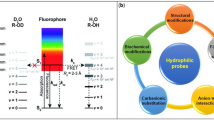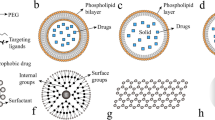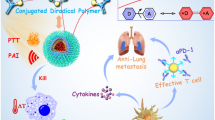Abstract
In this work, zwitterionic polymer (polyzwitterion) coating nanodiamonds (ND) with tumorous pH responsiveness were prepared for efficient application of commercial NDs in tumor cells imaging. Poly(carboxybetaine methacrylate) was firstly grafted on the pristine NDs (PCBMA-@-NDs) by surface-initiated reversible addition-fragmentation chain transfer (RAFT) polymerization. To achieve pH responsiveness and activated interaction with tumor cells, PCBMA-@-NDs were subsequently modified with benzene sulfonamide (PCBSA-@-NDs) via one step carbodiimide chemistry. The surface polymer functionalization was characterized by FTIR, 1H NMR and TGA, and PCBMA-@-NDs and PCBSA-@-NDs showed great dispersibility, enhanced fluorescence intensity and excellent antifouling property in contrast to pristine NDs. Moreover, PCBSA-@-NDs was able to switch zwitterionic surface (at pH 7.4) reversibly into positive charge (at pH 6.5) via protonated or deprotonated acylsulfonamide. As expected, PCBSA-@-NDs demonstrated higher cell affinity and better imaging performance than those of zwitterionic NDs at tumor slight acid environment, proven by fluorescence microscopy and flow cytometry. Overall, we provide a feasible and valuable strategy to construct smart NDs, thus encouraging the application of cost-effective fluorescence nanomaterials in biomedical fields.
Similar content being viewed by others
References
Nam J, Won N, Bang J, et al. Surface engineering of inorganic nanoparticles for imaging and therapy. Advanced Drug Delivery Reviews, 2013, 65(5): 622–648
Chang S L Y, Reineck P, Williams D, et al. Dynamic self-assembly of detonation nanodiamond in water. Nanoscale, 2020, 12(9): 5363–5367
Patel K D, Singh R K, Kim H W. Carbon-based nanomaterials as an emerging platform for theranostics. Materials Horizons, 2019, 6(3): 434–469
Radtke M, Bernardi E, Slablab A, et al. Nanoscale sensing based on nitrogen vacancy centers in single crystal diamond and nanodiamonds: achievements and challenges. Nano Futures, 2019, 3(4): 042004
Mochalin V N, Shenderova O, Ho D, et al. The properties and applications of nanodiamonds. Nature Nanotechnology, 2012, 7(1): 11–23
Sotoma S, Akagi K, Hosokawa S, et al. Comprehensive and quantitative analysis for controlling the physical/chemical states and particle properties of nanodiamonds for biological applications. RSC Advances, 2015, 5(18): 13818–13827
Passeri D, Rinaldi F, Ingallina C, et al. Biomedical applications of nanodiamonds: An overview. Journal of Nanoscience and Nanotechnology, 2015, 15(2): 972–988
Zhu Y, Li J, Li W, et al. The biocompatibility of nanodiamonds and their application in drug delivery systems. Theranostics, 2012, 2(3): 302–312
Reina G, Zhao L, Bianco A, et al. Chemical functionalization of nanodiamonds: Opportunities and challenges ahead. Angewandte Chemie International Edition, 2019
Tinwala H, Wairkar S. Production, surface modification and biomedical applications of nanodiamonds: A sparkling tool for theranostics. Materials Science & Engineering C: Materials for Biological Applications, 2019, 97: 913–931
Boudou J P, David M O, Joshi V, et al. Hyperbranched polyglycerol modified fluorescent nanodiamond for biomedical research. Diamond and Related Materials, 2013, 38: 131–138
Zhao J, Lu M, Lai H, et al. Delivery of amonafide from fructose-coated nanodiamonds by oxime ligation for the treatment of human breast cancer. Biomacromolecules, 2018, 19(2): 481–489
Lu M, Wang Y K, Zhao J, et al. PEG grafted-nanodiamonds for the delivery of gemcitabine. Macromolecular Rapid Communications, 2016, 37(24): 2023–2029
Wang D, Tong Y, Li Y, et al. PEGylated nanodiamond for chemotherapeutic drug delivery. Diamond and Related Materials, 2013, 36: 26–34
Chen B, Zhang Y, Zhang J, et al. PEGylated polyvinylidene fluoride membranes via grafting from a graphene oxide additive for improving permeability and antifouling properties. RSC Advances, 2019, 9(32): 18688–18696
Moore E, Delalat B, Vasani R, et al. Surface-initiated hyper-branched polyglycerol as an ultralow-fouling coating on glass, silicon, and porous silicon substrates. ACS Applied Materials & Interfaces, 2014, 6(17): 15243–15252
Shiraishi K, Yokoyama M. Toxicity and immunogenicity concerns related to PEGylated-micelle carrier systems: a review. Science and Technology of Advanced Materials, 2019, 20(1): 324–336
Kim H, Man H B, Saha B, et al. Multiscale Simulation as a framework for the enhanced design of nanodiamond-polyethyle-nimine-based gene delivery. The Journal of Physical Chemistry Letters, 2012, 3(24): 3791–3797
Xu D, Liu M, Zhang Q, et al. Preparation of water dispersible and biocompatible nanodiamond-poly (amino acid) composites through the ring-opening polymerization. Materials Science & Engineering C: Materials for Biological Applications, 2018, 91: 496–501
Chen H B, Gu Z J, An H W, et al. Precise nanomedicine for intelligent therapy of cancer. Science China: Chemistry, 2018, 61(12): 1503–1552
Zhai S, Ma Y, Chen Y, et al. Synthesis of an amphiphilic block copolymer containing zwitterionic sulfobetaine as a novel pH-sensitive drug carrier. Polymer Chemistry, 2014, 5(4): 1285–1297
Merz V, Lenhart J, Vonhausen Y, et al. Zwitterion-functionalized detonation nanodiamond with superior protein repulsion and colloidal stability in physiological media. Small, 2019, 15(48): 1901551
Park J, Nam J, Won N, et al. Compact and stable quantum dots with positive, negative, or zwitterionic surface: specific cell interactions and non-specific adsorptions by the surface charges. Advanced Functional Materials, 2011, 21(9): 1558–1566
Lim E K, Chung B H, Chung S J. Recent advances in pH-sensitive polymeric nanoparticles for smart drug delivery in cancer therapy. Current Drug Targets, 2018, 19(4): 300–317
Stuart M A C, Huck W T S, Genzer J, et al. Emerging applications of stimuli-responsive polymer materials. Nature Materials, 2010, 9(2): 101–113
Mura S, Nicolas J, Couvreur P. Stimuli-responsive nanocarriers for drug delivery. Nature Materials, 2013, 12(11): 991–1003
Piao J G, Gao F, Li Y, et al. pH-sensitive zwitterionic coating of gold nanocages improves tumor targeting and photothermal treatment efficacy. Nano Research, 2018, 11(6): 3193–3204
Abel B A, Sims M B, McCormick C L. Tunable pH- and CO2-responsive sulfonamide-containing polymers by RAFT polymerization. Macromolecules, 2015, 48(16): 5487–5495
Mizuhara T, Saha K, Moyano D F, et al. Acylsulfonamide-functionalized zwitterionic gold nanoparticles for enhanced cellular uptake at tumor pH. Angewandte Chemie International Edition, 2015, 54(22): 6567–6570
Ranneh A H, Takemoto H, Sakuma S, et al. An ethylenediamine-based switch to render the polyzwitterion cationic at tumorous pH for effective tumor accumulation of coated nanomaterials. Angewandte Chemie International Edition, 2018, 57(18): 5057–5061
Zhang Z, Chen S, Jiang S. Dual-functional biomimetic materials: Nonfouling poly(carboxybetaine) with active functional groups for protein immobilization. Biomacromolecules, 2006, 7(12): 3311–3315
Jiang S, Cao Z. Ultralow-fouling, functionalizable, and hydrolyzable zwitterionic materials and their derivatives for biological applications. Advanced Materials, 2010, 22(9): 920–932
Gutch P K, Singh R, Shaik M. Polymeric decontaminant: N,N-dichloro poly 2,6-dimethyl 1, 4-phenylene oxide sulfonamide: synthesis, characterization and efficacy against simulant of sulfur mustard. Journal of Polymer Materials, 2011, 28(1): 5–13
Neagu V, Vasiliu S, Racovita S. Adsorption studies of some inorganic and organic salts on new zwitterionic ion exchangers with carboxybetaine moieties. Chemical Engineering Journal, 2010, 162(3): 965–973
Chen J, Liu M, Huang Q, et al. Facile preparation of fluorescent nanodiamond-based polymer composites through a metal-free photo-initiated RAFT process and their cellular imaging. Chemical Engineering Journal, 2018, 337: 82–90
Abraham S, So A, Unsworth L D. Poly(carboxybetaine methacrylamide)-modified nanoparticles: a model system for studying the effect of chain chemistry on film properties, adsorbed protein conformation, and clot formation kinetics. Biomacromolecules, 2011, 12(10): 3567–3580
Hui Y Y, Cheng C L, Chang H C. Nanodiamonds for optical bioimaging. Journal of Physics D: Applied Physics, 2010, 43(37): 374021
Kang R H, Baek S W, Ryu T K, et al. Fabrication of blue-fluorescent nanodiamonds modified with alkyl isocyanate for cellular bioimaging. Colloids and Surfaces B: Biointerfaces, 2018, 167: 191–196
Sethuraman V A, Na K, Bae Y H. pH-responsive sulfonamide/PEI system for tumor specific gene delivery: An in vitro study. Biomacromolecules, 2006, 7(1): 64–70
Wang Z, Ma G, Zhang J, et al. Surface protonation/deprotonation controlled instant affinity switch of nano drug vehicle (NDV) for pH triggered tumor cell targeting. Biomaterials, 2015, 62: 116–127
Ou H, Cheng T, Zhang Y, et al. Surface-adaptive zwitterionic nanoparticles for prolonged blood circulation time and enhanced cellular uptake in tumor cells. Acta Biomaterialia, 2018, 65: 339–348
Acknowledgements
The authors gratefully acknowledge the financial support from the National Natural Science Foundation of China (Project U1704150) and the Scientific and Technological Projects of Henan province (182102410017).
Author information
Authors and Affiliations
Corresponding author
Additional information
Disclosure of potential conflicts of interests
The authors declare no potential conflicts of interests.
Rights and permissions
About this article
Cite this article
Zhou, B., Li, J., Lu, B. et al. Novel polyzwitterion shell with adaptable surface chemistry engineered to enhance anti-fouling and intracellular imaging of detonation nanodiamonds under tumor pHe. Front. Mater. Sci. 14, 402–412 (2020). https://doi.org/10.1007/s11706-020-0527-3
Received:
Accepted:
Published:
Issue Date:
DOI: https://doi.org/10.1007/s11706-020-0527-3




